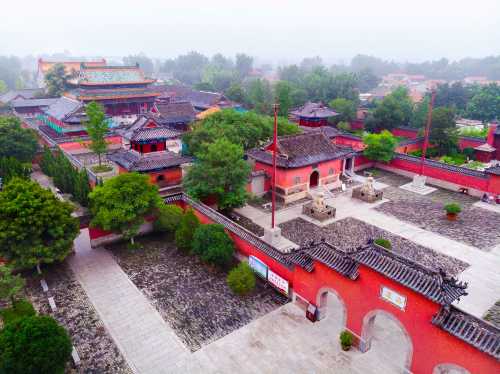Popular Trip Moments
Tracing the Suqian Dragon King Temple Palace: A 300-Year Epic of Water Control and Royal Elegance | At Santai Mountain, Encounter a Colorful Floral Extravaganza | Suqian Esports Hotel | A New Experience for Gaming Enthusiasts | I thought the Forbidden City was beautiful enough, until I came here... | Suqian Canal Jinling: Where beauty and comfort meet! | [Zaohe Secret Realm] A Three-Day Pilgrimage to the Imperial Palace and Water Control Epic | Suqian 2-Day Tour: A Hidden Gem of Water Towns in Northern Jiangsu | Atour Suqian, Your Starting Point for City Exploration! | Suqian | So Beautiful in April-May! A Hidden Gem for Tourism! | Experience Chinese culture at the Zen Garden Waterside Zen-themed Inn. | Jiangsu Suqian: A Wonderful Off-Season Trip in April and May with Fewer Crowds and Beautiful Scenery | Suqian Santai Mountain National Forest Park: A Healing Hiking Guide to the Misty Forest | Liba Hotel (Shuyang, Suqian) | The Most Magnificent Pear and Orchid Sea in Jiangsu!! | Yuezhuhotel: A cozy nest for budget travelers! | Trip to Suqian 🌸 | A Senior-Friendly Guide to Suqian and More: One Read Covers 10 Strategies
| 7-Day Tour of Dangshan, Yangzhou, and Huai'an: A Super Practical Guide | The pear blossoms and orchids at Santai Mountain in Suqian are stunning. | "How can you say you've been to Suqian if you haven't visited Santaishan National Forest Park?" | The seriously underestimated sea of flowers in Jiangsu 🌸 So beautiful in March and April that you will be speechless | Suffocated by the beauty of the pear blossom sea in Jiangsu! This is what spring should look like. | 3-Day Tour of Yangzhou, Suqian, and Taizhou: Your Essential Guide | Suqian 3-Day Itinerary | Suqian revisited, highly recommended by locals. | I just got back from Suqian, and I want to share my experience. | 5-Day Tour of Yangzhou, Suzhou, and Wuxi: A Super Detailed Guide | I have returned from Suqian after suffering so much punishment. Sisters who are planning to go there should be careful. | Let's meet at the most beautiful Pear and Orchid Flower Sea! | Pear and Orchid Rendezvous: A Stunning Spectacle in Jiangsu Santaishan National Forest Park
Popular Travel Types
Recommended Attractions at Popular Destinations
Bangkok attraction near me | Manila attraction near me | Tokyo attraction near me | Taipei attraction near me | Hong Kong attraction near me | Seoul attraction near me | Kuala Lumpur attraction near me | Los Angeles attraction near me | Shanghai attraction near me | New York attraction near me | Shenzhen attraction near me | Osaka attraction near me | Singapore attraction near me | London attraction near me | Guangzhou attraction near me | San Francisco attraction near me | Beijing attraction near me | Macau attraction near me | Bali attraction near me | Jakarta attraction near me | Paris attraction near me | Ho Chi Minh City attraction near me | Istanbul attraction near me | Phuket attraction near me | Chicago attraction near me | Seattle attraction near me | Toronto attraction near me | Orlando attraction near me | Cebu attraction near me | Chiang Mai attraction near me
Popular Attractions
Beijing Wildlife Park | Hong Kong Disneyland | Tianmen Mountain National Forest Park | Banff National Park | Phi Phi Islands | Insa-dong | Century Park | Top of Shanghai Observatory | Hongya Cave Cultural Center | Bund Sightseeing Tunnel | Boracay | Tsingtao Beer Museum | Dubai Frame | The Lost Chambers Atlantis | Pingshan Grand Canyon | Rabat Medina | Big Bus Muscat | Dalian Haichang Discoveryland Theme Park | Naina Devi Temple | Masjid Al Furqon | Pyörö Library | Fuente Plaza | Al-Huda Mosque | Chateau On The River | Parque Infantil | Football Field | Shani maruti tample | Biblioteca Comunale di Trento - Sede di Gardolo | Dubai Miracle Garden | Singapore Zoo
Popular Restaurants in Suqian
海底捞火锅(水韵城店) | 川锅一号火锅(宿迁店) | Xun jia wei su qian wei dao | 和福顺焖锅(沭阳店) | 千叶寿司(黄河公园店) | 项妃鸭(宿迁学院店) | 稻田熊·深海烤鱼(光明街店) | 新一烤肉(金鹰花园店) | 豚家烤肉(泗洪店) | CoCo都可(青阳店) | 渔越(花园口国际广场店) | 挪威森林(泗水新城店) | 青肴(宿迁学院店) | Shanmudashu | Chuanguoyihao (300lididaoshicaizhongyang) | 7Fentian (suchengbaolongguangchang) | 中德度假村中餐厅 | 雪姨手作(幸福南路店) | 必胜客(泗阳雨润店) | Daimei Hot Pot (baolongchengshiguangchang) | 蜀九宫(宝龙店) | 麦当劳(泗洪花园口店) | 必胜客(泗洪富园广场店PH店) | 韩宫宴炭火烤肉(宿迁宝龙广场店) | 山洞里烤肉(金鹰店) | 必胜客(中央广场店) | 方燕烤猪蹄(泗阳店) | 溢香园(泗中路店) | Ernicaijianbing (baolong) | 溢香园蛋糕(锦都豪庭店)
Popular Ranked Lists
Top 19 Local Restaurants in Huai'an | Top 10 Local Restaurants in Minsk | Top 10 Local Restaurants in Adelaide | Top 10 Local Restaurants in Ottawa | Popular Premium Hotels in Buruanga | Top 20 Local Restaurants in Xining | Popular Best Things to Do in Baiyin | Top 10 Local Restaurants in Phi Phi Islands | Top 4 Best Things to Do in Dongfang | Top 6 Best Things to Do in Jincheng | Top 4 Best Things to Do in Jinjiang | Popular Local Restaurants in Bangkok | Popular Premium Hotels in Taunggyi | Popular Luxury Hotels Near Warmbad | Top 7 Best Things to Do in Jining | Popular Luxury Hotels Near Wongaling Beach | Top 5 Best Things to Do in Huaihua | Top 10 Local Restaurants in Quito | Top 8 Local Restaurants in Izmir | Top 5 Best Things to Do in Xiangshan | Popular Luxury Hotels Near Burabay | Popular Best Things to Do in Jingmen | Popular Best Things to Do in Heze | Top 9 Local Restaurants in Lushan Global Geopark | Top 16 Local Restaurants in Ningde | Popular Best Things to Do in Qinzhou | Top 18 Local Restaurants in Jingdezhen | Top 6 Best Things to Do in Hezhou | Popular Premium Hotels in Jiangcheng | Popular Luxury Hotels Near Vila do Conde
Payment Methods
Our Partners
Copyright © 2025 Trip.com Travel Singapore Pte. Ltd. All rights reserved
Site Operator: Trip.com Travel Singapore Pte. Ltd.
Site Operator: Trip.com Travel Singapore Pte. Ltd.



















